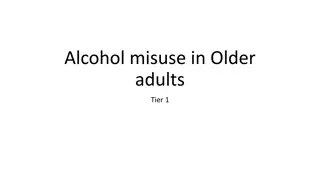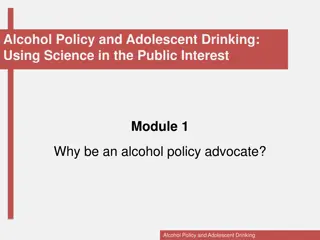Enhanced Mobile Ambulatory Assessment System for Alcohol Craving Studies
This Master's thesis defense presents an innovative system aimed at monitoring and predicting alcohol craving episodes in real-time. Motivated by the lack of reliable ambulatory assessment methods for alcohol craving studies, the thesis goals include enhancing a drinking craving Android application, implementing a server program for data interaction, and developing an automated analysis system. The prototype system utilizes external sensors, smartphone integration, and server programs to collect and analyze data effectively. New features of the system include automated survey scheduling, data encryption, server administration, and data visualization capabilities.
Download Presentation

Please find below an Image/Link to download the presentation.
The content on the website is provided AS IS for your information and personal use only. It may not be sold, licensed, or shared on other websites without obtaining consent from the author.If you encounter any issues during the download, it is possible that the publisher has removed the file from their server.
You are allowed to download the files provided on this website for personal or commercial use, subject to the condition that they are used lawfully. All files are the property of their respective owners.
The content on the website is provided AS IS for your information and personal use only. It may not be sold, licensed, or shared on other websites without obtaining consent from the author.
E N D
Presentation Transcript
1 AN ENHANCED MOBILE AMBULATORY ASSESSMENT SYSTEM FOR ALCOHOL CRAVING STUDIES Master s Thesis Defense Ruiqi Shi Advisor: Dr.Yi Shang
2 Overview Introduction Related Work System Architecture and Implementation Preliminary Result Summary and Future Work
3 Motivation What is Alcohol Craving ? Thoughts, physical sensations, or emotions that tempt subject to drink, even though the subject have at least some desire not to. NIAAA: 18 million - alcohol use disorder or alcohol dependence. NIDA: $30 - billion health care costs Not Much Reliable Ambulatory Assessment System for Alcohol Craving Studies No Accurate Methods for Alcohol Craving Episodes Prediction Reported in Ambulatory Alcohol Craving studies
4 Laboratory Assessment
5 Ambulatory Assessment
6 Comparison between Laboratory Assessment and Ambulatory Assessment Data Time Daily Data Collection Real-time Data Monitoring Precision Consuming Laboratory Assessment Ambulatory Assessment Higher Lower
7 Thesis Goals System to monitor/collect real-time factors and predict drink craving episodes. Goals: (more details) Implement and Enhance a Drinking Craving Android Application (aCraving) based on a prototype. Implement a Server Program to provide interaction with the mobile and monitoring on the real-time data. Implement an automated data analysis system to predict drink craving episode.
8 Prototype System External Sensors Smart Phone Networking Module Accelerometer Collection Equivital EQ02 Life monitor Server Program
9 Enhanced System (aCraving)
10 New Features Smart Phone Automated Survey Scheduling Survey Suspension/Break Suspension Subject Behavior/Phone Performance Monitoring System Restoring Data Recovering Data Encryption/Decryption Server Administration Management Data Processing and Generating Data Visualization
11 New Features(cont d) Data Analysis Data Cleaning and Refining Data Smoothing(extract global trend) and Visualization Feature Selection and Calculation for Generating Training Data Supervised Learning
12 Enhancement System Architecture Refactor Organized/Reusable Structure Responsiveness Multi-thread framework Security HTTPS Power Consumption Data Buffering System Component Optimization Survey Data Reliability Subject Identification Report Preciseness
13 Overview Introduction Related Work System Architecture and Implementation Preliminary Result Summary and Future Work
14 Related Work IPainRelief - A pain assessment and management app for a smart phone implementing sensors and soft computing tools , by Rajesh and Joan, SRM University, India, ICICES,2013. A Pain Assessment and Management App IPainRelief for a Smart phone Uses Fuzzy Expert Systems No experimental results
15 Related Work(cont d) E.W. Boyer, R. Fletcher, R.J. Fay, D. Smelson, D. Ziedonis, and R.W. Picard, Preliminary efforts directed toward the detection of craving of illicit substances: the iHeal project, J Med Toxicol. 8(1):5-9, March 2012. A Drug Craving System and Management App for a phone Sensor Data Detection, Random Assessment and self- report No Real-time Data Collection
16 Related Work(cont d) Real-time Data Monitoring Real-time Sensor Data Collection System- triggered Report Experiment Result Target Pain No Result IPainRelief intensity Drug Craving Episode Drink Craving Episode Not Shown iHeal Preliminary Result aCraving
17 Overview Introduction Related Work System Architecture and Implementation Preliminary Result Summary and Future Work
18 System Environment External Sensor: EQ02 Life Monitor Deployed Phone: MOTO DROID Samsung Nexus Nexus 4. Android OS: 4.4, 5.0. Server OS: Linux
20 Enhanced System Architecture
21 System Implementation External Sensor Module Mobile Computing Module Server Subject Monitoring Module Machine Learning Module
22 Mobile Computing Module Phone Monitoring Module Data Collection Networking Module Data Recovering Module Background Service Module Utility Module Scheduling Module Account Management Module Survey Module
23 Mobile Computing Module Enhancement Security Hypertext Transfer Protocol Secure (HTTPS) Protocol Hybrid Cryptosystem
25 Mobile Computing Module Enhancement Responsiveness Multi-thread framework Enhanced Design Previous Design Worker Thread 1 Activity UI Thread Activity UI Thread Task OnClickEvent ANR Window Pop up Worker Thread 1 OnClick Event Time-consuming Task (Network Access) New Click Request Task
26 Mobile Computing Module Enhancement Power Consumption Transmission Data Buffering Power consumption reduced by 28.6 % 1000 Power Consumption (measured in micro watts) 100 10 1 Without Buffers With Buffers Test Cases
27 System Implementation External Sensor Module Mobile Computing Module Server Subject Monitoring Module Machine Learning Module
28 Sensor Data Chart Example
29 Location Data Example
30 System Implementation External Sensor Module Mobile Computing Module Server Subject Monitoring Module Machine Learning Module
31 Data Analysis Module Pre-processing Module Fit Missing Data: Linear Interpolation; Spline Interpolation Graphic Module Smoothing Spline Sampling Module Machine Learning Module
33 Graphic Module Responsible for Curve fitting/smoothing to extract global trend
34 Supervised Learning
35 Collected Dataset Dataset Data are sorted by the timestamp Data Size around 2540 * 5 Proportion of the Drink Craving Episode Data is low around 6/2540 (0.23%) Drink Craving Episode Data is collected with deviation System-trigger survey Self-report survey Result of Directly Applying Machine Learning Method
36 Expansion Method-Expansion Step Generating Drink Period by increasing the drink range around the drink report time.
37 Expansion Method-Conversion Step Using Moving window to convert the drink period prediction to drink craving episode prediction by calculating the proportion of drink-data in the window
38 Shrink Methods Shrink Step A Moving Window is utilized to compress the training dataset
39 Shrink Methods Conversion Step
40 Evaluation Test Drink Craving Episode Data Entry Accepted Range Predicted Drink Craving Episode Data Entry Deviation
41 Preliminary Result
42 Preliminary Result (cont.)
43 Overview Introduction Related Work System Architecture and Implementation Preliminary Result Summary and Future Work
44 Summary Mobile Computing Module provides reliable long-term real-time data collection. provides reliable real-time survey assessment. provides reliable survey scheduling functions. provides secure data storage and transmission. Server Monitoring Module provides reliable real-time monitoring and visualization. Promising automated data analysis module is deployed. aCraving System has been used in real subjects for several months.
45 Future Work Mobile Computing Module: Data for Communication between Server and Phone Alternative Module for New External Sensors Bluetooth 4.0 Support Data Analysis Module: More supervised Learning Methods Unsupervised Learning Methods Survival Analysis Model























